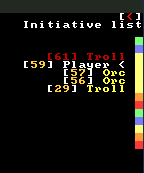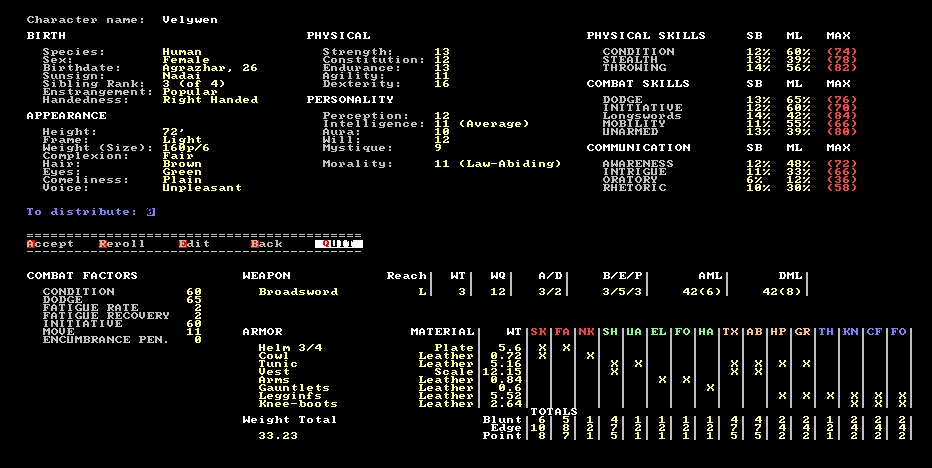hrose
Educated
- Joined
- Jan 6, 2003
- Messages
- 90
This is vaporware.
But also a concrete project I tinkered with in spare time for the past few years. I'm the kind of guy who is unable to think and plan realistically, so instead of making a game that is within reach I instead plan for the most epic, insane RPG that can be conceived. Also, I cannot really code, even making a simple menu takes me an insane amount of hours, so it would take me many, many lives to even get close to the plan I have.
Why doing this? Because it's fun. I enjoy experimenting with rulesets and tinkering with game systems more than I enjoy playing a good game. And maybe 50 years in the future there would be someone like minded, but with far better technical skills, who could pick up my plans and actually deliver a game that is fully old-school yet progressive, the same as I plan mine.
This project is built on concrete ideas and goals and that's what I'm going to write about. It's vaporware because it cannot realistically be completed, but the groundwork is solid.
The very best, but obviously unlikely, scenario is that someone actually is interested and helps me with code actively. After all this project exists because I had people helping me with suggestions as I moved along, but everything would change if there was someone who can actually write code and implement stuff without spending 20 hours on a 4-options menu like I do.
General summary and plan:
A roguelike-like game, mostly ASCII, coded in C++ and libtcod (but because I don't really know C++ it's mostly standard C spaghetti code written at a very, very low skill level). Everything I make is open source.
The plan is to have character creation for one character and eventually a party up to 4. So three more companions that can be recruited in-game, and then managed directly after they join. Rogue-like ASCII top-down perspective. When out of combat it works like a "blobber", so you just move around your party. When combat starts you "deploy" the party on the same top-down map, and combat becomes turn-based and tactical, with a sort of action points system. When combat is over you're back to blobber mode.
The rulest would be built as very old-school pen and paper RPG with explicit rules and dice rolls. But the aim is to make a mechanically very, very complex and intricate system. Not only I implement and adapt well known complex systems, but I blend them to take every noteworthy mechanic. The systems I already worked on use a blend of these rulesets: Harnmaster, Harnmaster Gold, Dangerous Journey, The Riddle of Steel, Rolemaster, Elric!, AD&D 2nd, Pathfinder. I take a mechanic, analyze how it's used in each of these different P&P systems, and then blend all into one trying to retain the interesting bits of each.
Because the foundation is Harnmaster, the system has no levels or hardcoded classes, and it would be entirely skill based.
The features that are not roguelike are: it's planned to have a fully handcrafted world and no permdeath. Instead of trial & error & experimentation of classic roguelike gameplay, it encourages to play and experiment on the same character and dig deep in the story/lore. It's open-world.
Theme: it's an almost-classic RPG with a "gritty", Dark Soul-ian theme. Because of this, the world is "artificial". It's not a realistic reconstruction of a bucolic medieval world. There's not a castle with farmers working nearby. It's a deliberate game space. This is part of the concept and the story (I want to use Shin Megami Tensei as inspiration here). The plan would be to have very dense philosophical and metaphysical themes, and I plan to outdo Torment at its own game (I know what I'm doing)
(I know what I'm doing)
As I have time I'll explain more details about how the combat system works (including the plan to use abilities layered on top of a standard skill based system), and what I plan as the structure for the first dungeon, the general feel of how dungeon exploration is supposed to work, style of dialogue, and also "research" to be done about blending in systems from other outlandish games, including Vagrant Story (breaking down and rebuilding equipment) and Umineko (?) (specifically: color-coded truths).
I think reading about these outlandish ideas can be interesting, even if they aren't going to be implemented any time soon, or ever. I only wish I could code at an acceptable speed and get more things actually done...


But also a concrete project I tinkered with in spare time for the past few years. I'm the kind of guy who is unable to think and plan realistically, so instead of making a game that is within reach I instead plan for the most epic, insane RPG that can be conceived. Also, I cannot really code, even making a simple menu takes me an insane amount of hours, so it would take me many, many lives to even get close to the plan I have.
Why doing this? Because it's fun. I enjoy experimenting with rulesets and tinkering with game systems more than I enjoy playing a good game. And maybe 50 years in the future there would be someone like minded, but with far better technical skills, who could pick up my plans and actually deliver a game that is fully old-school yet progressive, the same as I plan mine.
This project is built on concrete ideas and goals and that's what I'm going to write about. It's vaporware because it cannot realistically be completed, but the groundwork is solid.
The very best, but obviously unlikely, scenario is that someone actually is interested and helps me with code actively. After all this project exists because I had people helping me with suggestions as I moved along, but everything would change if there was someone who can actually write code and implement stuff without spending 20 hours on a 4-options menu like I do.
General summary and plan:
A roguelike-like game, mostly ASCII, coded in C++ and libtcod (but because I don't really know C++ it's mostly standard C spaghetti code written at a very, very low skill level). Everything I make is open source.
The plan is to have character creation for one character and eventually a party up to 4. So three more companions that can be recruited in-game, and then managed directly after they join. Rogue-like ASCII top-down perspective. When out of combat it works like a "blobber", so you just move around your party. When combat starts you "deploy" the party on the same top-down map, and combat becomes turn-based and tactical, with a sort of action points system. When combat is over you're back to blobber mode.
The rulest would be built as very old-school pen and paper RPG with explicit rules and dice rolls. But the aim is to make a mechanically very, very complex and intricate system. Not only I implement and adapt well known complex systems, but I blend them to take every noteworthy mechanic. The systems I already worked on use a blend of these rulesets: Harnmaster, Harnmaster Gold, Dangerous Journey, The Riddle of Steel, Rolemaster, Elric!, AD&D 2nd, Pathfinder. I take a mechanic, analyze how it's used in each of these different P&P systems, and then blend all into one trying to retain the interesting bits of each.
Because the foundation is Harnmaster, the system has no levels or hardcoded classes, and it would be entirely skill based.
The features that are not roguelike are: it's planned to have a fully handcrafted world and no permdeath. Instead of trial & error & experimentation of classic roguelike gameplay, it encourages to play and experiment on the same character and dig deep in the story/lore. It's open-world.
Theme: it's an almost-classic RPG with a "gritty", Dark Soul-ian theme. Because of this, the world is "artificial". It's not a realistic reconstruction of a bucolic medieval world. There's not a castle with farmers working nearby. It's a deliberate game space. This is part of the concept and the story (I want to use Shin Megami Tensei as inspiration here). The plan would be to have very dense philosophical and metaphysical themes, and I plan to outdo Torment at its own game
As I have time I'll explain more details about how the combat system works (including the plan to use abilities layered on top of a standard skill based system), and what I plan as the structure for the first dungeon, the general feel of how dungeon exploration is supposed to work, style of dialogue, and also "research" to be done about blending in systems from other outlandish games, including Vagrant Story (breaking down and rebuilding equipment) and Umineko (?) (specifically: color-coded truths).
I think reading about these outlandish ideas can be interesting, even if they aren't going to be implemented any time soon, or ever. I only wish I could code at an acceptable speed and get more things actually done...


Last edited:













